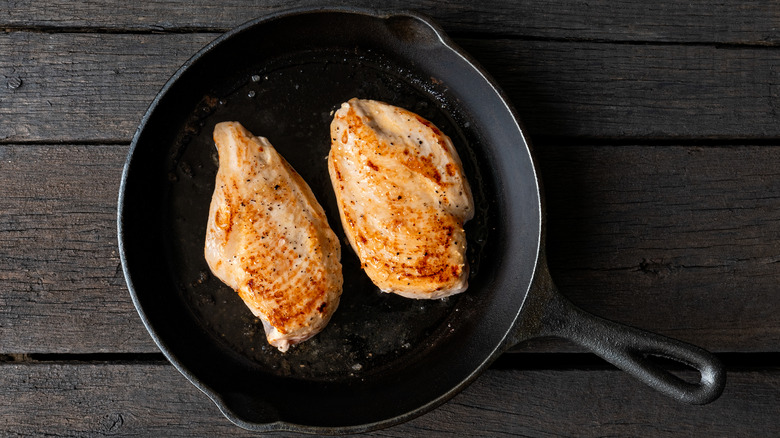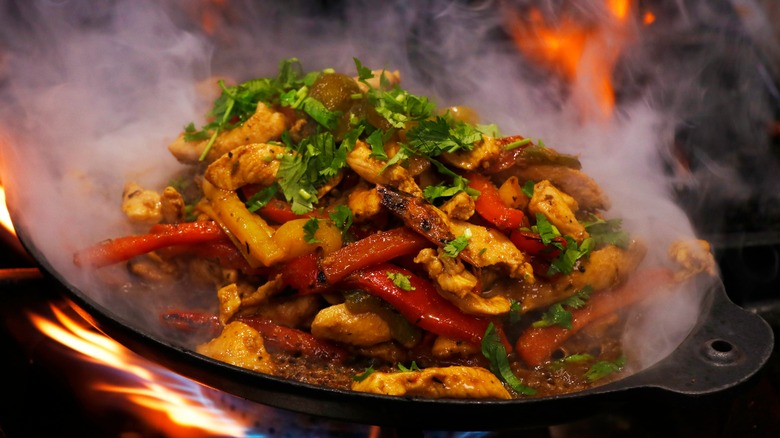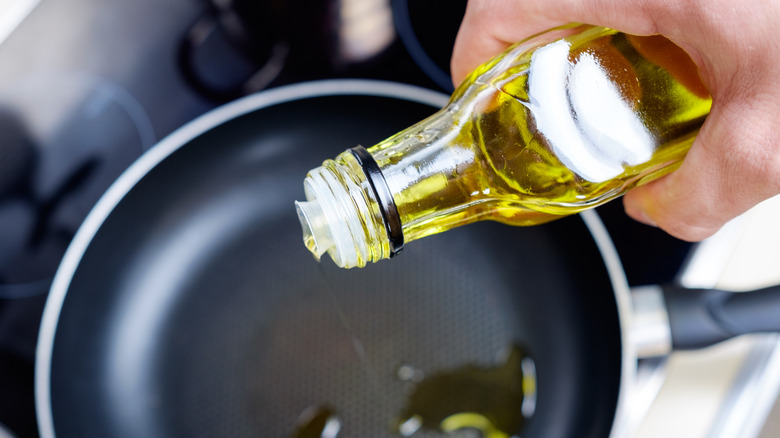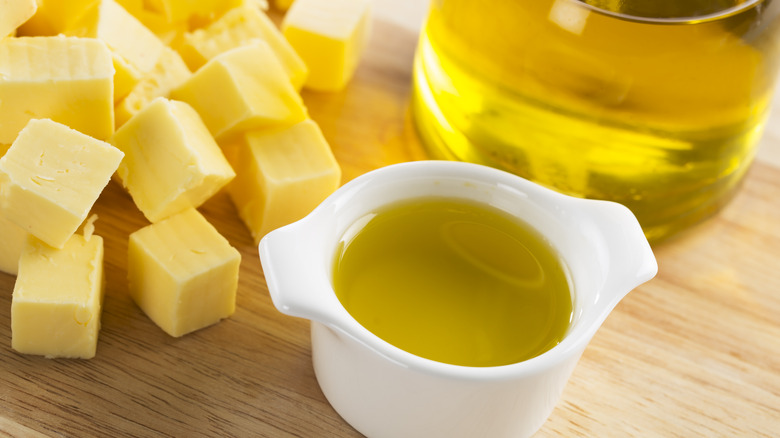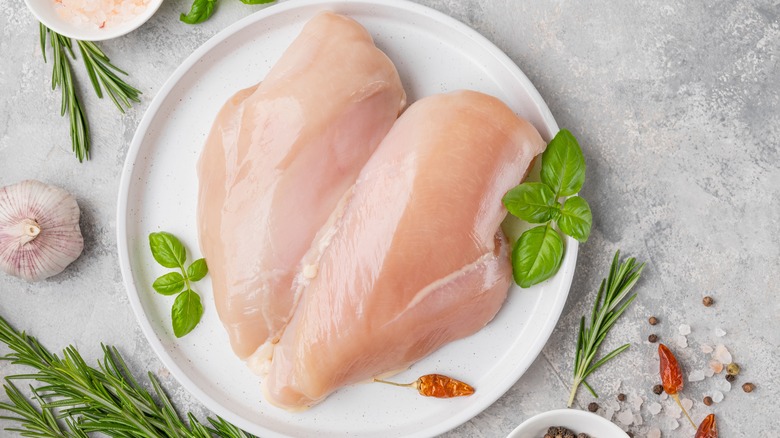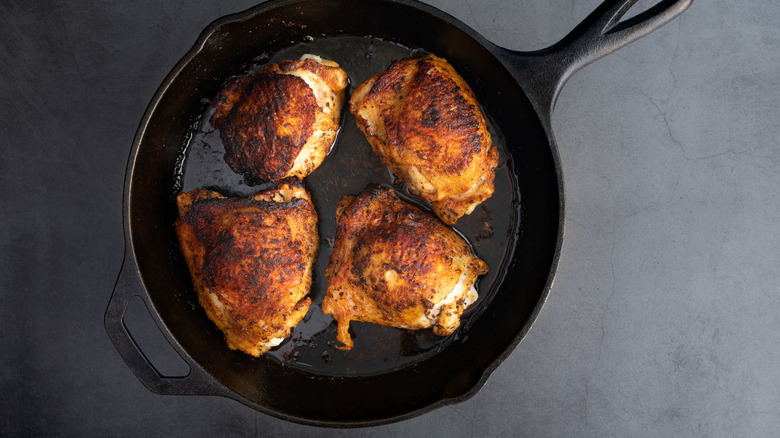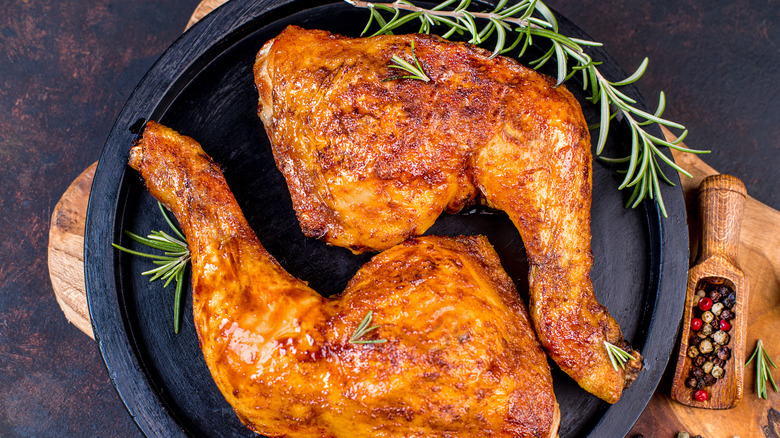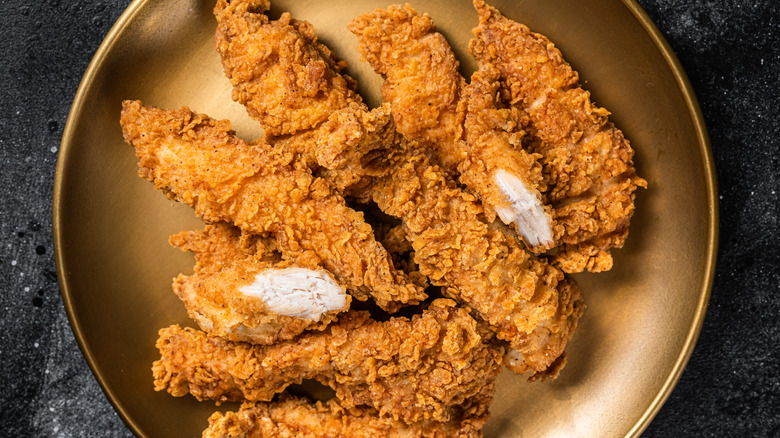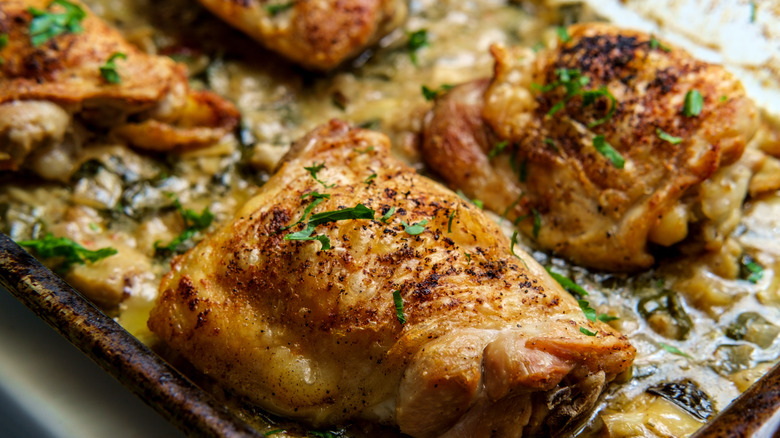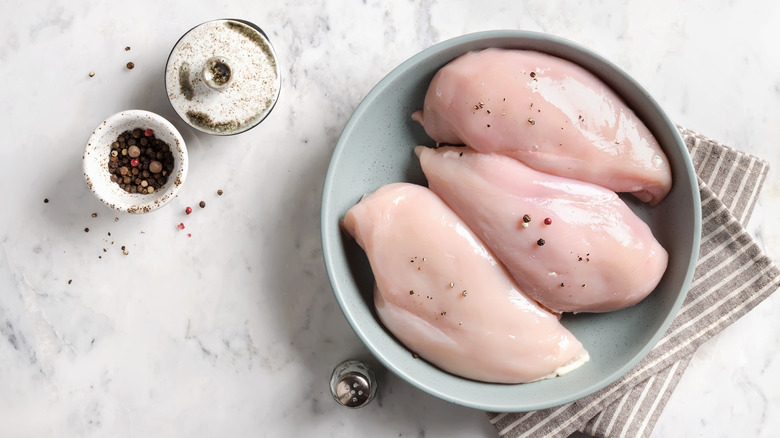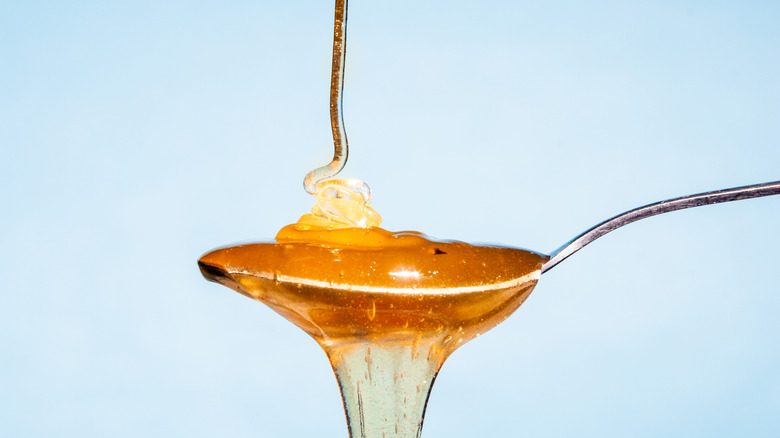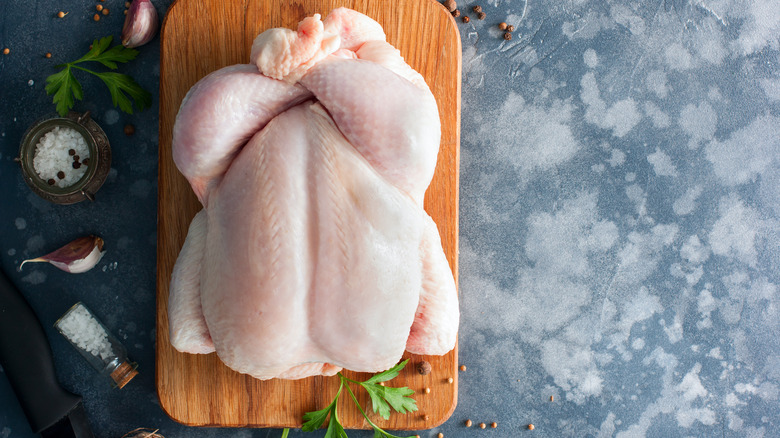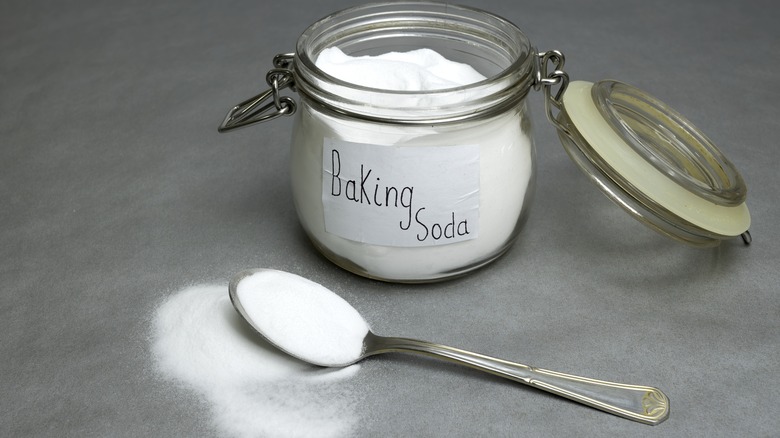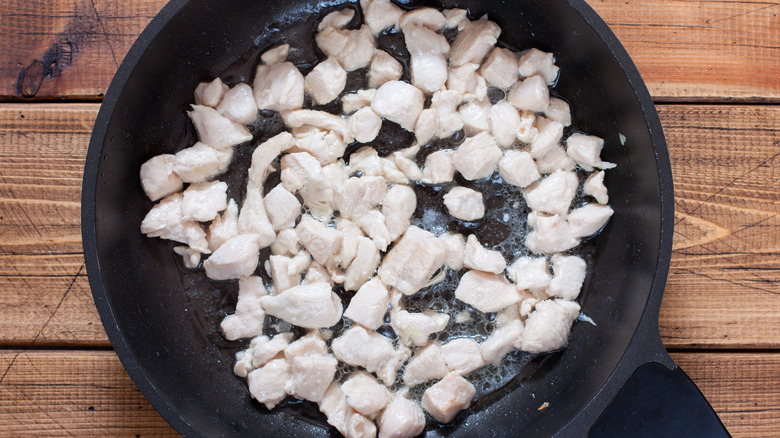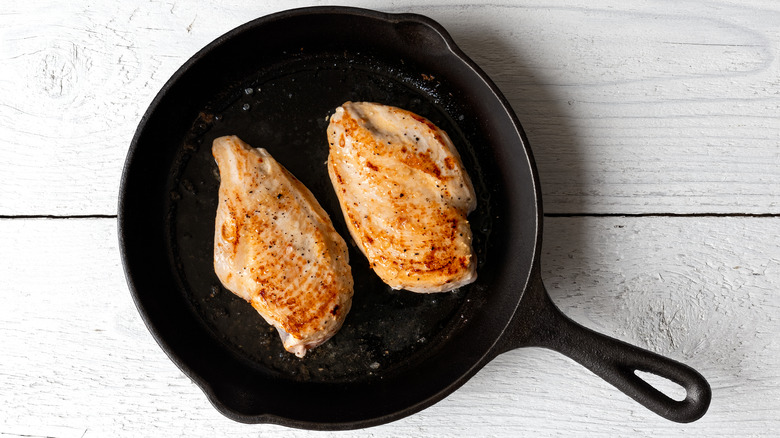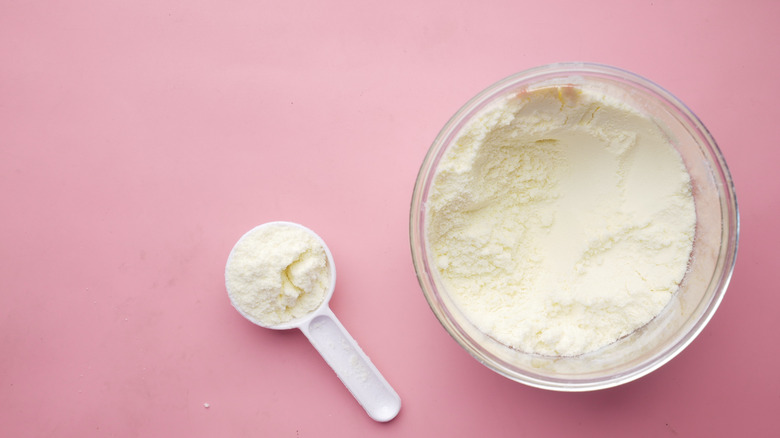15 Tips You Need For Getting Better Browned Chicken
Chicken is one of the most popular proteins consumed in America, but this white meat can be tricky to cook. Nobody likes bland, pale, flabby chicken, and we can't blame them. Boneless, skinless chicken breasts, in particular, have a bad reputation for being one of the most flavorless foods if cooked improperly. Luckily, there are several helpful tips and tricks that can help you achieve that oh-so-flavorful browning on chicken.
That golden brown color isn't just a visual aspect — the flavor is locked in there as well. This is because of the Maillard reaction, a chemical reaction between the amino acids in protein and sugar that creates the color and flavor we love on seared meat, roasted vegetables, and toasted marshmallows, among other things. No matter whether you're cooking breasts or thighs, grilling or roasting, there is bound to be a tip on this list that can help achieve golden brown coloring.
Make sure your pan is hot
Perhaps one of the most important things you can do to have beautifully browned chicken when searing is to make sure your pan is nice and hot. Start with a dry pan over medium-high heat, then add a drizzle of cooking oil. When the oil begins to lightly smoke, it's ready to add chicken. The added benefit of cooking with an amply hot pan is that foods like chicken will be less likely to stick.
Cooking with a hot pan can come with one caveat to watch out for. If you cook the outside of the chicken too quickly, the chicken could be browned on the outside but still raw on the inside. It becomes a delicate balance between finding the right temperature to brown the meat while adequately cooking the inside. Keep in mind that you can always start with a high heat when searing and then turn the heat down to finish cooking the inside without burning the outside.
Use enough oil
While some foods can be cooked in a dry pan, chicken is simply not one of them. An ample amount of oil in the pan provides a conduit between the heat of the pan and the meat itself. Too little oil often results in uneven cooking, sticking, and other unsavory outcomes. Too much oil is less of an issue, though you do run into the problem of shallow-frying your chicken instead of searing it.
For a regular eight or nine-inch skillet, somewhere between one and two tablespoons of oil should be the perfect amount. When the oil hits the hot pan, swirl it around. It should fully cover the bottom in a thin, even layer. This method works perfectly for vegetable oil, corn oil, or even olive oil. Save the extra-virgin stuff for serving, though, as most of its flavor will be lost by the high heat.
Try a combination of fats
OK, so we already covered using an ample amount of oil when searing chicken. To maximize the flavor, you can also sear chicken in two types of fat. This method is favored for chicken recipes of all kinds, but there are a few tricks to keep in mind. For maximum browning, start the chicken in oil to sear it, then turn the temperature down low and add the butter. Tilt the pan towards you slightly and spoon the hot butter over the chicken again and again. The chicken will continue to brown where the butter is added, as well as cook internally.
This process is called butter basting and works not just for chicken, but for steak and pork chops as well. It's a method preferred by many restaurant chefs who need to achieve delicious and perfectly cooked meat in as little time as possible.
Thoroughly dry the chicken
Moisture is the enemy of browning. When the chicken is placed in a hot pan, the moisture on the surface will cause the pan's temperature to drop, which can inhibit the Maillard reaction and the development of a flavorful browned crust. Additionally, the steam that is generated from the moisture can cause the chicken to become overcooked or rubbery. By drying the chicken thoroughly before cooking it, you can help to ensure that it browns evenly and develops a nice crust. This will also help to lock in the flavors and create a more appealing and delicious finished dish.
Always pat chicken dry with a clean, dry paper towel before cooking. An alternate method to drying chicken out is to simply refrigerate it overnight uncovered on a baking sheet or plate. The circulating air in the refrigerator should be enough to remove moisture from the outside of the chicken.
Employ the pan/oven combo
Another common method loved by restaurant chefs is a one-two combo of stovetop and oven cooking. This combination cooking method for foolproof crust on chicken is a simple way to get a perfectly browned exterior while also completely cooking the interior. The stovetop provides the kind of high, direct heat that is needed for that beautiful browning, and the oven has a gentle, surrounding heat that can continue to cook the meat without burning the outside.
The only drawback to this method is that it requires you to have both your stovetop and oven on simultaneously, and for some people it is just not worth the effort to heat the oven up all the way just to be used for a few minutes. This isn't a problem for restaurant chefs, who have ovens that are on for the duration of dinner service, but home cooks don't always have the luxury.
Use spices generously
This next tip may feel like a bit of a cheat, but delicious, golden-brown chicken is never a bad thing, no matter how you get there. Utilizing a spice rub (like the ancho chile version in this grilled chicken recipe) can be a great way to add both color and flavor to chicken. The spices themselves add color to the exterior of the meat so you will be able to achieve browning even without higher temperatures or a large amount of oil. The good news is that spice rubs are incredibly easy to make and there are some all-purpose blends that can be used for almost anything.
This trick can work particularly well for oven-baked chicken, which can be a notoriously difficult method to achieve browning with but is sometimes necessary for nutritional or other reasons. Spice rubs are suitable for any cooking method except poaching (but you really wouldn't be concerned with browning using that method anyway).
Bread it for easy browning
When all else fails, a complete course correction can sometimes be the answer. Breading your chicken before cooking is a no-fail way to achieve browning that always works when done well. Classic breaded chicken recipes, like this easy chicken Parmesan, are a tried-and-true method for delicious, golden-brown chicken. You can bread chicken with a classic dredging method as is used on fried chicken, or a more simple coating of panko breadcrumbs or cornflakes.
Even just a simple coating of plain or seasoned all-purpose flour can help brown chicken. Wondra flour is the super-fine ingredient that is loved by chefs like Julia Child and Jacques Pépin, who considers it the secret to perfectly crisp fried chicken breasts. Just like with a spice rub, this trick works because the flour itself begins to brown along with the chicken, which contributes to an overall more browned appearance and a more delicious flavor.
Keep the skin on
There's a reason that roasted, skinless chicken never caught on. As much as some people will always believe that skin on chicken is the enemy, there really is a ton of flavor to be found there. Chicken skin has a way higher fat content than the muscle so it has a much easier time browning. Plus, it's not all that unhealthy for you, after all. If you would like to see more browning on your chicken, consider picking up some skin-on breasts or thighs and making a nice pan-fried chicken thigh for dinner.
Leaving the skin on your chicken has the unique property of becoming crispy once properly browned, a delicious phenomenon that can't exactly be replicated on skinless cuts. The fat that renders out of the skin while cooking also leaves the meat much juicier and reduces your risk of ending up with the dreaded dry chicken.
Use salt to draw out excess moisture
Many people think that adding salt to food adds flavor and while that is true, salt plays other important roles in the cooking process. By salting the chicken a few hours before cooking (or even overnight), any moisture in the flesh of the chicken itself will get drawn out by the salt. That moisture turns to steam during the cooking process and disrupts the Maillard reaction, leaving you with less-than-desirable chicken.
Before cooking, pat the chicken completely dry with a paper towel to remove the liquid. This process is sometimes referred to as "dry brining" and works especially well with skin-on chicken, which can have a tendency to absorb and hold on to moisture. Don't worry about this trick making your chicken dry — the moisture is only removed from a thin layer on the exterior of the chicken where it makes contact with the salt.
Add a touch of sweetness
We already know that the Maillard reaction occurs between sugars and amino acids naturally occurring in meat. While you can certainly achieve delicious brown chicken without adding a thing, there is one sweet ingredient that can seriously boost your results. Adding honey to chicken, either in the form of a marinade or applied directly to the outside, will dramatically increase the amount of browning on your chicken. The science behind this is simple — sugars caramelize with enough heat. Add some kind of sugar to chicken, and voilà: perfect, golden-brown chicken.
Substitutes for honey that work just as well could be sugar (or brown sugar), maple syrup, or something more exotic like pomegranate molasses. Anything with a high sugar content will brown with enough heat — even thick sauces like barbecue or even ketchup. This trick will definitely speed up the cooking process (at least on the exterior), so check your chicken often to avoid burning.
Start with the right bird
Even with all the tricks and tips on this list, there can still be a source of sub-par browning that starts before you even begin cooking. The type of chicken you buy plays a large role in the amount of browning you can expect to see. This happens because some kinds of commercially-raised chicken are cooled in a chlorinated water bath while others are air-chilled. Both kinds are completely safe to eat, but the chicken that takes a soak will end up more waterlogged than the air-chilled kinds.
If you have ever wondered why you sometimes cook chicken that releases a ton of juice (and other times barely any), this could be the reason. Don't worry about this loss of liquid, though, because it won't make your chicken taste dry. The moisture we are talking about here is located in the skin or very outside of the meat.
Baking soda can help
We discussed how dry brining with salt can help dry out the exterior of a piece of chicken to get it primed and ready for perfect browning, but there is another ingredient to add to the brine that can help even more. The ingredient is baking soda, and this simple culinary trick can help to break down the proteins in the chicken, which makes the meat more tender and helps it to brown more evenly when it is cooked.
To use this technique, mix together equal parts baking soda and salt, and rub the mixture onto the surface of the chicken. Allow the chicken to sit in the mixture for at least 30 minutes, or up to 24 hours in the refrigerator. When you are ready to cook the chicken, rinse off the dry brine and pat the chicken dry with paper towels before cooking it as you normally would.
Don't crowd the pan
It's a common culinary adage: don't overcrowd your pan. But what's the harm? Actually, a lot, if you are looking for top-tier browning. Crowding a pan while cooking is one of the easiest ways to ensure that your food never browns at all, let alone unsatisfactorily. Most foods release some amount of moisture while cooking, and this is especially true with chicken. Some kinds of chicken will release more moisture than others, depending on how the bird was processed.
When searing a single chicken breast over high heat, this moisture evaporates as quickly as it releases, so you likely won't see any in the pan. On the flip side, if you overcrowd your pan with cubed chicken, the sudden addition dramatically lowers the temperature of the pan while the close proximity of each piece traps steam. All this leads to a pan full of water without a speck of browning in sight. To avoid this, make sure that any piece of chicken has at least an inch of space around it and work in batches if needed.
Use the right pan
When searing chicken, the pan or skillet you use to cook in can make all the difference in the world. We already discussed the need for high heat, so that unfortunately rules out nonstick pans. Nonstick pans have a special coating that isn't recommended for use with high heat — no, really, check the manual. The best materials for searing are tried-and-true cast iron, stainless steel, and carbon steel. These types of pans are all preferred by professional chefs and will stand the test of time.
All of these metals can withstand the temperatures needed to brown chicken and will allow you to transition seamlessly from stovetop to oven, if necessary. Unless you are cooking a single, small chicken breast at a time, opt for a standard eight or nine-inch pan. Perhaps it goes without saying, but if your pan has warping or an uneven bottom, it's time to toss it.
Use milk powder
When all else fails, there is a secret ingredient to perfectly brown chicken. As we already mentioned, browning on the surface of chicken comes from the Maillard reaction. It's essentially the caramelization of sugar and protein, both of which are already present in chicken. But what if there was a magical ingredient that contained both sugar and protein that you could add to boost that golden brown color?
Enter milk powder, the result of dehydrating cow's milk. Milk powder is often used as a pastry chef's secret weapon and can be used to make ice creams richer and cookies chewier. When browning chicken, milk powder can be used in marinades, spice rubs, or simply sprinkled on top before cooking. Be careful about the amount you use, however, as this powder has a tendency to skew things to the sweet side. Even a small amount of it will have big results.
